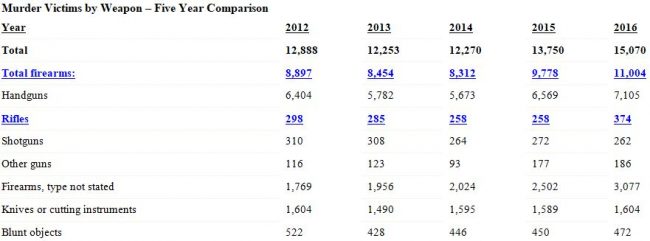
In this Chicago crime scene image from 2016, police investigate one of more than 700 slayings that year in the Windy City. (Source: Screen capture, YouTube, MaggioNews)
By Dave Workman
Senior Editor
For the second straight year, violent crime has risen in the U.S., according to data from the newly-released FBI Uniform Crime Report for 2016, but those interested in more gun control, such as bans on so-called “assault weapons” as a solution, may have trouble explaining why.
Homicides increased by 8.6 percent last year, according to the report, with an estimated 17,250 homicides, although the expanded homicide data for that year shows a total of 15,070 slayings.
Continuing a long-term trend, rifles of any kind are still used in just a fraction of the total homicides. Of the homicides in 2016, of which 11,004 were linked to firearms, only 374 were specifically attributed to rifles of any kind, although the report shows 3,077 of those murders involved unidentified gun types.
The number of slayings with knives or other “cutting instruments” was up to 1,604 – the same figure in 2012 – and another 472 people were killed with blunt objects such as hammers, crowbars, baseball bats, clubs or other instruments.
Once again, more people appear to have been beaten to death with hands or feet (656) than were killed with rifles and shotguns combined (636), the report details.
One curiosity is found in Washington State, where gun control proponents have been claiming an “epidemic of violence.” But in 2016 the number of homicides actually declined to 195, from 209 in 2015. Of those, 127 involved firearms last year, down from the 141 gun-related murders the previous year. (See the state-by-state figures here.)
However, in 2016 the number of active concealed pistol licenses in Washington soared by 61,898. By the end of last year, there were 571,476 active CPLs in the state, up from the 509,578 posted on Dec. 31, 2015 by the state Department of Licensing.
In a state where anti-gunners have been pushing to ban so-called “assault weapons” for several years, rifles of any kind were involved in only 11 of those 127 gun-related slayings. Almost half of them were killed in one of highest-profile crimes in the state that year, the multiple homicide at Burlington’s Cascade Mall in which the killer used a .22-caliber rifle. That’s more than the three teens who died in the Mukilteo shooting less than two months earlier, which involved a .223-caliber Ruger rifle often misidentified as an “assault rifle.”
Seattle-based gun prohibition lobbying groups can’t even argue that passage of their Initiative 594 in 2014 had an impact because the Mukilteo killer passed a background check and the Burlington killer took the .22-caliber rifle from home without permission, making the issue moot.
On the other hand, California – where several gun control laws have been adopted over the past few years – saw an increase in gun-related homicides, from 1,275 in 2015 to last year’s 1,368.
According to the FBI, overall violent crime went up 4.1 percent last year over the previous year, but property crime declined 1.3 percent from 2015. That continues a 14-year trend.
Is the problem more gun ownership, or gun laws that apparently don’t work?
Arizona, which has “constitutional carry” without any sort of required permit, posted 336 murders last year, of which 227 involved firearms. According to the Arizona Department of Public Safety, as of Sept. 24 there were 321,291 active concealed carry permits in the state, where they have a “shall issue” law for those who qualify and want a permit for reciprocity reasons.
Neighboring California, with some of the strictest gun laws in the country and a “may issue” scheme that leaves many people unarmed, there were 1,930 homicides last year, of which 1,368 involved firearms, according to the FBI chart.
But there is not a firm pattern on this. Texas reported 1,459 murders last year, including 1,066 that involved guns.
New York, with its stronger gun laws, had an estimated 628 murders, opposed to the 611 reported in 2015, but fewer of those slayings involved guns. The spike was in stabbings, showing that when someone is determined to kill, they’ll find a weapon.
Overall violent crime rose 4.1 percent last year but property crime fell 1.3 percent continuing a 14-year trend that has seen steadily declining property crime.
One thing these figures once again illustrate is that when the gun prohibition lobby talks about “33,000 people a year die from ‘gun violence,’” they are including suicides and accidental deaths along with homicides under the term “gun violence.” Second Amendment advocates say that is disingenuous at best.




